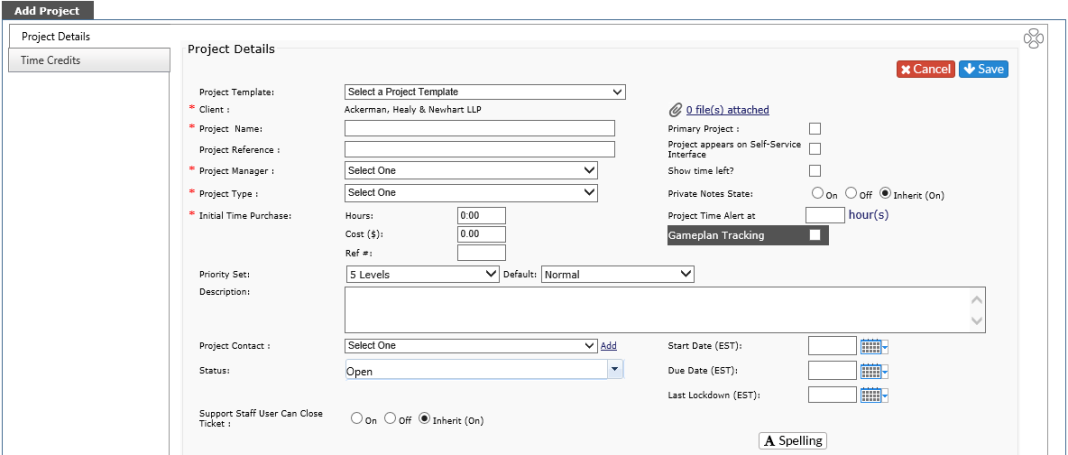Add Project |
|
A project is definite task list or related actions that are grouped together for resource and cost tracking purposes.
When a client signs off on a new project, the information can be added here, including the initial time purchase. Any additional time purchases are added in the Time Credits area.
Project Details
Project Template: If templates are turned on, you may select a predetermined template.
*Client: Use the pull down to select the company
*Project Name: Type in the Project Name
Project Reference: A Task Order number, Contract number or other reference number used by your company, if required.
*Project Manager: Select the appropriate PM from the pull down list
*Project Type: Select the appropriate one from the pull down menu.
*Initial Time Purchase: Put in the Hours, Cost and Reference number for the project. The reference number can be a quote or contract number.
Attach File: If Attachments is active via licensing, and the options allow, files can be attached against the project information. This could be a copy of the contract, or other specific project information.
Primary Project: If this option is checked, this project will appear as the default for all users when logging a ticket. It will also show in bold in the listing of the client's projects.
Project appears on Self-Service Interface If this option is checked, the client can see their open tickets, receive email notifications and see reports on the project based on their Access Level. If it is not checked, the option to publish a report is not available through Time Reconciliation reports.
Show Time Left: If this box is unchecked, the remaining time on the project will not show within a ticket internally or the External Client reports.
Private Notes State: If On, all action notes will be logged as Private Notes. If off, all action notes will be visible to client in a report or on the Self-Service Interface. Inherit (On) is for Revelation clients who have an existing system.
Project Time Alert at _____ hour(s) : If the project is based on a time limit, an alert can be set when the project has a specified number of hours remaining. For example: The client purchased a 100 hour block of time. If the alert is set at 20, once 80 hours have been used, an email alert will be sent out to the appropriate staff.
Gameplan Tracking: If you have the Gameplan module active, and it is required for this project, check the box. It will then associate the Start and Due dates below with the project for proper tracking.
Priority Set: Select the Priority Set for the project from the drop down and then select the default level.
NOTE: To change the Primary Project, go into the project you wish to have as the primary and check Primary Project. You will be asked if you want to change the project. Click OK to change the project, or Cancel to retain the existing primary project.
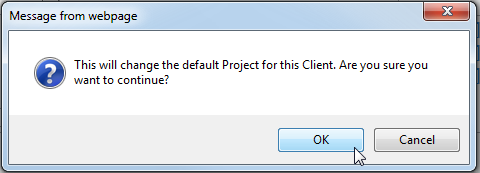
Description: Enter a brief description of the project (WAN installation, pre-purchased block of time, Web development, etc.).
Project Contact: Select a contact from the pull down list as the primary contact for this particular project.
Status: Open (default), Closed or On Hold
Start Date: The date the project is scheduled to begin.
Due Date: Project completion date, if known. This can be an estimate.
Last Lockdown: Date shown is when the last report was published for the project. If you publish a monthly report for clients through the Time Reconciliation report, this date will reflect the last day of the month published.
Support Staff User Can Close Ticket: On allows staff to close ticket; Off requires an Admin to close the ticket. Inherit will follow what is already in your system.
Project Template Edits
If the project is associated with a template, edits can be made to the overall template or to just the project associated with the client.
Use Template Settings
If you wish to remove the project from the Template settings, uncheck the Use Template Settings box by the Project Template name. Any edits to the project will not affect the template. If any changes are made to the template, the updates will not affect the unchecked project
Click here to edit Template Settings
Click on this link to go back to the Template and make any edits/changes required. When the template is reapplied, the changes will be rolled out to all associated clients.
Project Tabs
Click on each tab to set the following items:

Alerts
Takes the information from the Default Alerts set under Helpdesk Setup - Email Settings. Notifications can be altered by project here. To use the Default Alerts for the project, ensure the Use Default Alert Settings box is checked.
An additional column is included called Static List. Notifications will be sent to the selected Internal User(s) even if they are not part of the project. Multiple users can be selected by clicking on the arrow and holding the Ctrl key while choosing staff.

The area at the bottom of the section has a drop down. This allows you to set how emails sent from within a ticket. When Support Staff is selected, the emails sent from within the ticket will be from the Staff member's email address. If System is chosen, the email will come from the system email address as defined in Helpdesk Setup - Email Settings - Email Configuration.
Rates
Different Project roles may have different rates associated with them. The rates shown are the default set in the system in Roles. The client’s rates may be different and can be edited here.
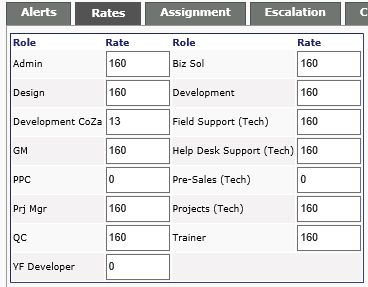
Ticket Assignment
When a client logs a ticket in Revelation, the ticket automatically shows up on the ”Assigned User” home page. If the default person is incorrect, or there should be additional personnel assigned for this project, select them from the right side (Unassigned Users) and move to the left side (Assigned Users), or vice versa, using the arrows or by dragging from one side to the other.
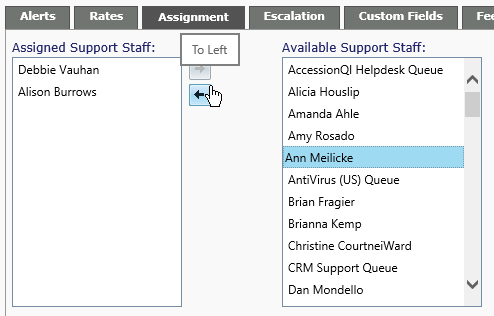
Escalation
Projects have an option to set any number of escalation targets, either Users or Queues, when an SLA is either at risk or is due. Upon reaching the date, based on the SLA for the project, the system will automatically assign the Ticket to the Users or Queues designated in the Project.
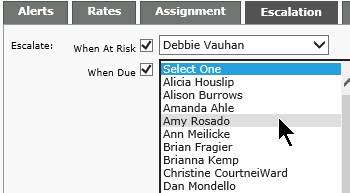
Custom Fields
If a Custom Field is to be used for any tickets logged against the project, it can be selected here. This will include the form when any ticket is logged against the project. It also gives the option to show the form on the Self-Service Interface, if it is active.

Feedback Survey
If used, select the appropriate Feedback Survey from the drop down.

Service Level Details
The Priority Response and Resolved times are set by the SLA. You can select multiple SLAs for a project, but one must be checked to be the default.
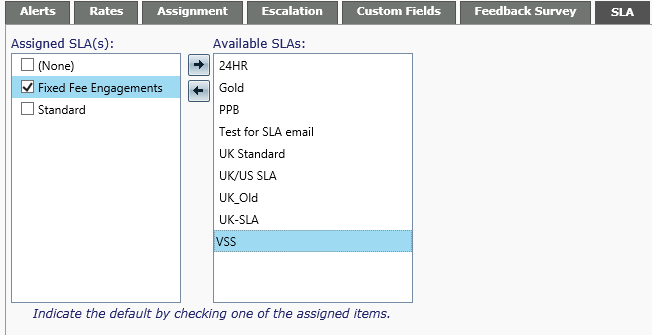
Email Parser
If you have set up an email parser account for this project, select it from the list on the right and move to the left to activate.

Project ID
Once project is created, there will be a Project ID number in parentheses next to the Project Info title.

Project Summary
Once the project is created, you will see additional tabs, including Project Summary. This tab gives a quick overview of the Project Details including the Client name, Project Manager, Contact, Time left, Status, Start/Due/End dates and the Project Description.

Ticket History
This tab shows all open tickets against the project. If you click on the ticket, you will be taken to the action notes. To see closed tickets for the project, check the Include Closed Tickets box at the top of the screen. The screen will automatically refresh with any additional tickets. The status will show which are open or closed.

Time Credits
This tab shows a history of the time credits added for the project. You will also be able to add or edit credits for the project from this tab. To delete a credit, click on the delete icon.
NOTE: You will only be able to edit the Initial Time Purchase. It cannot be deleted.


